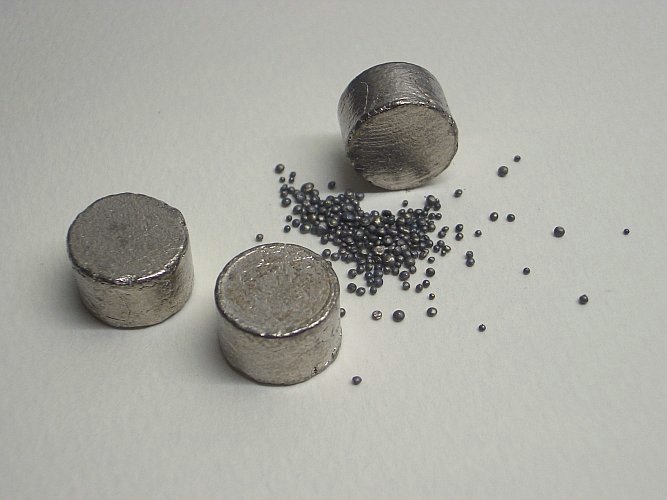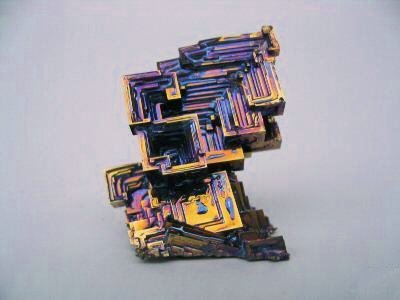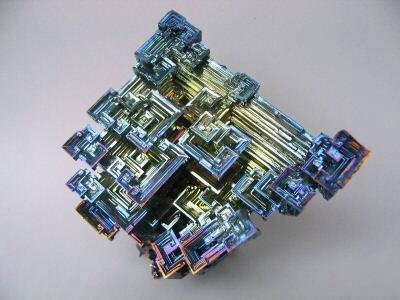


Bismuth
 Bismuth is a silvery crystalline metal with a faint
yellow/red cast. It is moderately reactive. In air it slowly tarnishes, but it
does not loose its metallic lustre completely. Bismuth frequently is sold in the form of small cylindrical
pieces of 10 to 25 grams each, which are perfectly suitable for chemistry experiments.
The picture shows three such pieces, each piece being 10 grams of bismuth.
Bismuth is a silvery crystalline metal with a faint
yellow/red cast. It is moderately reactive. In air it slowly tarnishes, but it
does not loose its metallic lustre completely. Bismuth frequently is sold in the form of small cylindrical
pieces of 10 to 25 grams each, which are perfectly suitable for chemistry experiments.
The picture shows three such pieces, each piece being 10 grams of bismuth.
The metal can be dissolved in concentrated nitric acid, but the reaction becomes very slow, once some bismuth has gone in solution already. Other acids hardly attack the metal. Solutions of bismuth, dissolved in nitric acid can be used as the basis for further experiments with bismuth. Bismuth is cheap, especially the non-decorative cylindrical form. Spending a few dollars on 100 gram of bismuth metal is definitely worth the money.
A remarkable property of bismuth is that the tarnished metal can have beautiful colors. Large crystals of the metal can be grown. When the bismuth becomes covered by a thin layer of oxide, then it remains reflective, but it gets all kinds of colors, due to optical effects. Numerous specimens of bismuth are offered on eBay as decorative items, sometimes for just a few dollars. Two examples are given here. Real size of these specimens is approximately 5 cm across.


These specimens consist of very pure bismuth, covered by an extremely thin oxide layer. When such a nice colorful specimen of bismuth is put in dilute nitric acid, then the color disappears and the specimen becomes metallic.
Bismuth is the heaviest element from the periodic table, which is not radioactive, at least from a practical point of view. Some sources on Internet claim that bismuth is radioactive, but with such an extremely long half time, that its radiation is even less than the background radiation from cosmic rays, radioactive particles in the air, etc.
![]()
The most common oxidation state of bismuth is +3. In some ill-defined compounds, it can have oxidation state +5 as well. Bismuth (III) ion is a colorless ion. It is very prone to hydrolysis. Even in moderately strong acids, there is strong hydrolysis already and a precipitate of bismuth oxo-compounds is produced very easily. When bismuth metal is dissolved in concentrated nitric acid and the liquid is diluted with some water, then a large amount of the bismuth precipitates as 'basic bismuth nitrate', which is a hydrous compound containing bismuth (III), nitrate and hydroxide/oxide.
In the presence of chloride, solutions of bismuth can be kept clear, also at somewhat lower concentration of acid, due to formation of a complex ion, BiCl4–. With iodide, bismuth forms a black precipitate of BiI3, which on addition of more iodide ion dissolves again, forming an intensely colored yellow/orange complex BiI4–.
Compounds of bismuth, available for the general public are sparse. Some, but certainly not all, ceramics and pottery suppliers have the non-basic salt bismuth nitrate, Bi(NO3)3·5H2O. This is a white solid, which dissolves in water, but the solutions are very turbid, due to hydrolysis and formation of basic hydroxide/nitrate/bismuth compounds, which precipitate from the solution. When bismuth metal is available, then bismuth nitrate is not really necessary.
It is quite remarkable that bismuth is relatively non-toxic for humans. Compounds of all heavy elements, surrounding bismuth in the periodic table are among the most toxic for humans (e.g. lead, thallium, mercury, antimony). Although the metal is not really toxic for humans, it is best not to flush bismuth waste down the drain. Bring such waste to a waste processing facility.